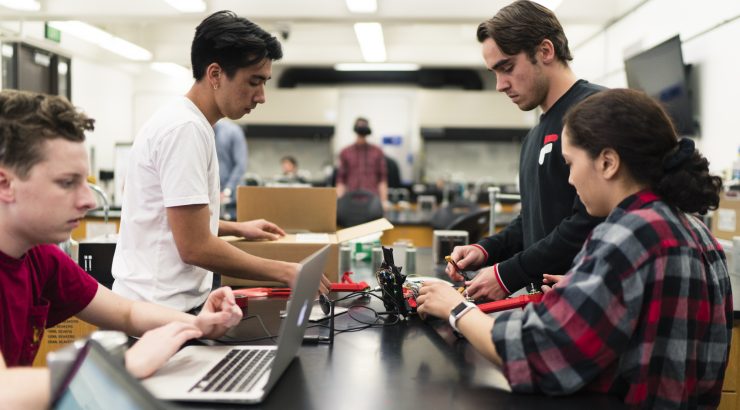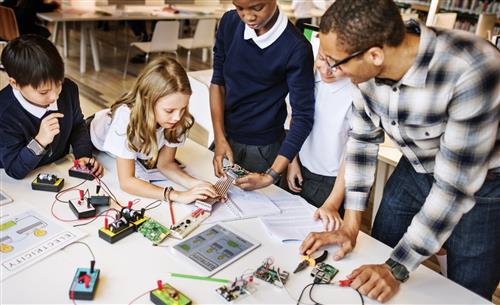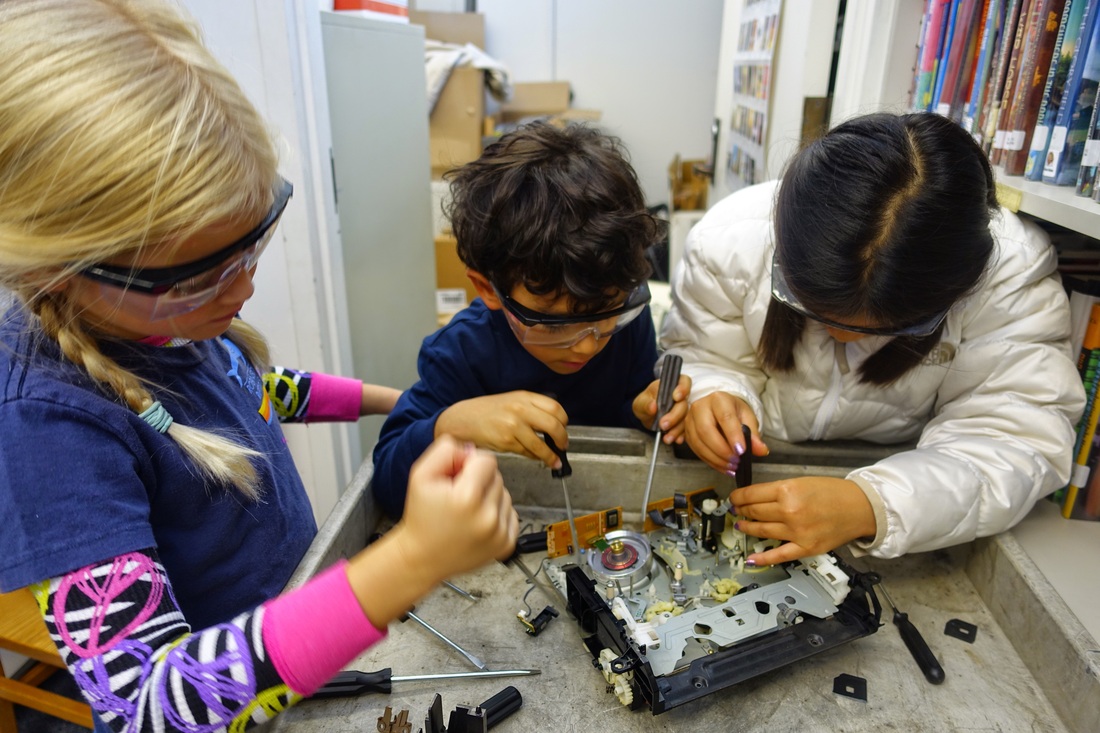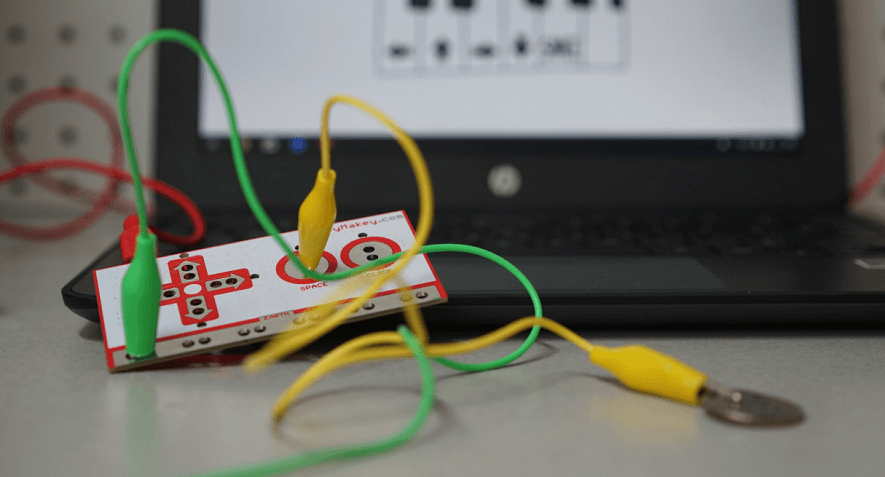If you’re ready to foster your students’ curiosity by creating a makerspace on a budget, we’ve got you covered!
Learning should remain authentically connected to the real world, and the Maker Movement exemplifies that while encouraging creativity, collaboration, and critical thinking. Progressive New York City educator Angelo Patri said, “The substitution of direct experiences for indirect ones leads nowhere.”

By The Room 241 Team
Makerspaces: a place for dreaming, creating, and experimenting
Makerspaces encourage students to try, fail, and try again—just as the world’s most amazing innovators do in their labs and studios every day. Makerspaces range from elaborate fabrication shops to small book carts full of craft supplies, but no matter the size or amount of equipment, they need only foster curiosity, discovery, and learning. According to The Makerspace Playbook, “A collection of tools does not define a makerspace. Rather, we define it by what it enables: making.” Heck yeah!
Without further ado, if you’ve got the blessing from your administrators (or perhaps you are the administrator in charge of this effort), let’s get your school up and running with makerspaces that rock.
The STEAM + makerspace connection
The terms STEAM and makerspace are often thrown around together. Here’s why: The STEAM education movement emphasizes 21st-century skills, project-based learning, and the interconnectedness of academic subject areas. Teaching STEAM helps students become more proficient in collaboration, questioning, problem-solving, and critical thinking. How do makerspaces fit in? Makerspaces are a hands-on method for STEAM learning, giving students space to explore science, technology, engineering, arts, and mathematics.
Step 1: Study up and network
When it comes to starting a makerspace, you don’t have to reinvent the wheel and you’re definitely not alone. Start by picking up a few reading materials you can reference all year (this guide is just meant to get you started!) and connecting to the myriad of like-minded educators across the country, sharing their ideas and advice. The web is full of brilliant suggestions for makerspace supply lists, project ideas, and tools for managing STEAM-based maker programs in schools. Follow STEAM teachers on social media, search YouTube for relevant videos, visit a makerspace if you can, and test some projects out on your own. Whatever your budget or makerspace dream, there is a lot of support available to make it a reality. Do your homework and jump on in.

Step 2: Bring the outside world in
School budgets can’t always cover makerspace supply costs—but that shouldn’t hinder your efforts. Your best bet? Ask your community for help. Makerspaces can use everything from cardboard boxes to office supplies to popsicle sticks. In other words: one business’ trash is a young inventor’s treasure. First, come up with a list of projects and necessary supplies. Then, deliver the list to local businesses, tack it to the community board in your local cafe, and post it on social media. Think about parents too—what do they often throw away that you could use? Glass baby food jars = paint holders. Empty tissue boxes = supply containers. Chances are, you’ll get much of what you need for free.
Beyond supplies, take advantage of the expertise and talents of your neighbors as well. Bringing in members of the community for maker demos and class projects bridges the gap between classroom learning and the outside world. Invite your local electrician to help kids build a light-up circuit, or bring in a construction expert to help design the perfect tiny house. Collaboration at its finest.
Step 3: Turn any space into a makerspace and give time to explore
Local and school-based libraries around the country are swiftly becoming makerspaces—a natural extension, as libraries have always been a central location for community learning. But take a good walk around your own school, noting where you could easily manipulate the space to offer the chance for low-stakes creative STEAM-based learning and for bigger group projects too.
When students finish eating in the cafeteria, for example, why not let them engage in some freestyle crafts or games? Create wipeable placemats by laminating old checker boards or Scrabble boards. If you’re a teacher with your own classroom, consider decking out one corner with supplies and cozy seating—you could even block it off with a makeshift curtain so it feels like its own lab. Have a storage closet collecting dust? Make it a secret Maker Lair!

Step 4: Start a design challenge practice
Once you’ve got a makerspace assembled, commit to making creativity and innovation routine in your school by hosting regular design challenges. Whether weekly, monthly, or once a semester, design challenge events can quickly build maker momentum in your school community; they can be school-wide, grade-wide, or classroom-based, and work well when both competitive or merely for learning. The goal is to get students engaged in design thinking, collaboration, and problem-solving.
What could a design challenge look like? Task students with creating the ultimate board game, and then have a game night with families and students to test them out. Or challenge students to reimagine a classroom, let them vote on the winning design, and actually renovate the space. Identify a community issue and task students with developing a solution for it. To keep the maker culture alive with regular participation, use the element of surprise by announcing “Drop Everything & Make” challenges or create a design challenge schedule for the year.
Step 5: Get creative with the curriculum
While makerspace learning time need not always live within the high-stakes curriculum, maker education should connect to classroom learning. Consider ways to incorporate maker projects into your everyday unit and lesson plans, as well as long-term projects. Doing so cements the association between real-world curiosity and experimentation to more structured and measured classroom instruction.
To build upon your students’ natural curiosity and creativity, it’s good to have unstructured makerspaces where materials are left out for students to independently manipulate or use to complete a challenge without the looming shadow of evaluation. However, embedding maker culture into curriculum learning creates a long-term practice with measurable outcomes.
To make it work, guide students toward identifying and understanding learning targets and then engage them in self-reflection and revision—just like real innovators. Need ideas? The internet is full of ready-made and free makerspace lesson plans for all subject areas.
Want to discover more resources to create a Makerspace in your school?
Check our products page and start your STEM lessons with RobotLAB! and our learning Platform EngageK12!

This article is original from room 241: https://education.cu-portland.edu/blog/classroom-resources/create-steam-makerspace/



